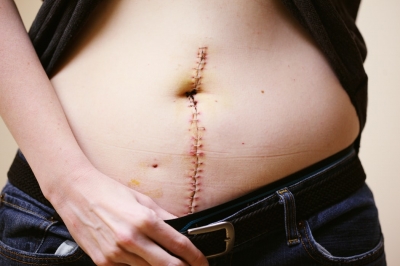How to look after your surgery scar

Having any kind of surgery can be tough, but it’s the healing afterwards that often presents the biggest challenges. It’s not just the physical reminder of having gone under the knife that’s a problem; the psychological impact of scarring can be as big as the issue you had ’fixed’.
You may also be worried that a scar isn’t healing fast enough or looks worse than you think it should. While all scars are going to look and behave differently from person to person, here are some things you can do to help your scar through the healing process.
Scar healing has four stages:
1. Haemostasis
As soon as you’ve been patched up, blood will start rushing to the site of your surgery to start clotting and stopping the bleed. That process starts immediately and lasts a few minutes.
2. Inflammation
Once that haemostasis has been achieved, cells will start to repair the wound. The wound will get hotter as the cells get to work, it’ll get more painful and redness will start to spread - and all of those sensations can last for around four days.
3. Proliferation
From day four, the tissue around the wound contracts - slowly reducing the area of the wound as it heals.
4. Remodelling
Around 21 days after surgery, deeper structures begin to form and that process can carry on for two years. It’s during this time that you might start to experience signs of keloid or hypertrophic scarring, which include raised, thickened, sensitive, itchy red scars.
It’s so important to know how to look after your skin post-surgery. It’s not just about caring for it immediately after undergoing the knife; the healing process can last a long time and so should your self-care.
Help scars heal in four easy steps
1. Keep the wound clean
It goes without saying but keeping the wound clean is of the utmost importance. If a wound becomes infected, it can be incredibly serious. If you do have any concerns or notice any signs of infection contact your Healthcare Professional.
Wash your wound under running water with a saline solution or use an alcohol-free disinfectant.
2. Avoid too much sun exposure
Scar tissue is incredibly sensitive - it’s not like the tough upper layer that’s covered with fine hairs. It’s really easy for scar tissue to get sunburnt if you don’t cover it up when you’re outdoors. If your scar is on a body part that you can’t cover up with clothing (or it’s too hot to do so), make sure that you apply some kind of SPF to the skin. There are certain scar treatments that offer added SPF - such as KELO-COTE® Scar Gel UV, which has SPF 30.
3. Swerve very hot water
Scars can itch and scratching already sensitive skin which may be held together with stitches could cause further damage. You want to avoid irritating skin any further, and very hot water can often make itchy skin worse. Make sure that if you do have a bath or shower, you test the water with your elbow first to make sure it’s a reasonable temperature. If a bath is a little too hot, keep the scar out of the bathwater and you can always rinse it under luke-warm water from the tap when you get out.
4. Use a silicone scar treatment
The body has an incredible capacity for repair. As soon as you’ve had surgery, your body will start pumping out collagen to try to heal the wound. Occasionally, however, it produces clunky bundles of collagen which push upwards to form a red, raised, hard scar. You should always discuss treatments with your Healthcare Professional, one option may be silicone gel. Once the wound has healed and stitched have been removed, you can help to soften old and new scars* by applying a silicone-based treatment on the affected area. This will flatten out the skin and help to reduce dis-colouration.
 A scar treatment like KELO-COTE® can relieve itching, reduce redness and is quick-drying.
A scar treatment like KELO-COTE® can relieve itching, reduce redness and is quick-drying.
KELO-COTE® is an advanced formula, topical silicone gel that’s clinically proven to prevent or improve the appearance of hypertrophic or keloid scars in around 82% of patient. It caters for scars of varying shapes and sizes, which is why it comes as a silicone gel, a spray and a UV gel with SPF 30. It’s simple to apply and dries within five minutes†, making it perfect for wearing under makeup.
Concerned that your scar is too old for treatment? If it’s four years or younger, this kind of sili-cone-based product can still soften skin, reduce redness and help flatten the scar.
To find out more, visit the KELO-COTE® website.
*Scars up to four years old.
†Data on file, study on 10 subjects. When used in accordance with instructions.
- Company
- Alliance Pharmaceuticals plc
- Address
- Avonbridge House, Bath Road, Chippenham, Wiltshire SN15 2BB, UK
- Telephone
- 01249 466966
- Int. Telephone
- +44 1249 466966
- Website
- kelo-cote.co.uk
Information contained in this Articles page which doesn’t state it has been written by talkhealth, has been written by a third party, and has been published with their permission. talkhealth cannot vouch for or verify any claims made by the author, and we do not endorse any specific products, brands, or treatments mentioned. The content in our Articles pages should not be considered a substitute for medical advice. You should always seek medical advice before changing your treatment routine.
Last revised: 28 July 2020
Next review: 31 December 2020
